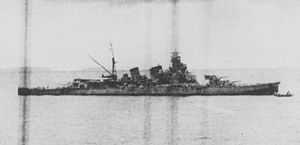
Back معركة كيب أسبرانس Arabic Batalla del cabu Esperanza AST Bitva u mysu Esperance Czech Slaget ved Kap Esperance Danish Schlacht von Cape Esperance German Batalo ĉe kabo Espero Esperanto Batalla del cabo Esperanza Spanish نبرد کیپ اسپرانس Persian Bataille du cap Espérance French קרב כף אספרנס HE
| Battle of Cape Esperance | |||||||
|---|---|---|---|---|---|---|---|
| Part of the Pacific Theater of World War II | |||||||
 The heavily damaged Japanese cruiser Aoba disembarks dead and wounded crew members near Buin, Bougainville and the Shortland Islands a few hours after the battle on 12 October 1942 | |||||||
| |||||||
| Belligerents | |||||||
|
|
| ||||||
| Commanders and leaders | |||||||
| Norman Scott |
Aritomo Gotō † Takatsugu Jojima | ||||||
| Units involved | |||||||
| Task Force 64 | 6th Cruiser Division | ||||||
| Strength | |||||||
|
2 heavy cruisers 2 light cruisers 5 destroyers |
3 heavy cruisers 2 destroyers reinforcement convoy (indirectly involved): 6 destroyers 2 seaplane tenders | ||||||
| Casualties and losses | |||||||
|
1 destroyer sunk 1 heavy cruiser damaged 1 light cruiser severely damaged[1] 1 destroyer severely damaged 2 floatplanes[1] 163 killed[2] |
1 heavy cruiser sunk | ||||||
The Battle of Cape Esperance, also known as the Second Battle of Savo Island and in Japanese sources as the Sea Battle of Savo Island (サボ島沖海戦), took place on 11–12 October 1942, in the Pacific campaign of World War II between the Imperial Japanese Navy and United States Navy. The naval battle was the second of four major surface engagements during the Guadalcanal campaign and took place at the entrance to the strait between Savo Island and Guadalcanal in the Solomon Islands. Cape Esperance (9°15′S 159°42′E / 9.250°S 159.700°E) is the northernmost point on Guadalcanal, and the battle took its name from this point.
On the night of 11 October, Japanese naval forces in the Solomon Islands area—under the command of Vice Admiral Gunichi Mikawa—sent a major supply and reinforcement convoy to their forces on Guadalcanal. The convoy consisted of two seaplane tenders and six destroyers and was commanded by Rear Admiral Takatsugu Jojima. At the same time but in a separate operation, three heavy cruisers and two destroyers—under the command of Rear Admiral Aritomo Gotō—were to bombard the Allied airfield on Guadalcanal (called Henderson Field by the Allies) with the object of destroying Allied aircraft and the airfield's facilities.
Shortly before midnight on 11 October, a U.S. force of four cruisers and five destroyers—under the command of Rear Admiral Norman Scott—intercepted Gotō's force as it approached Savo Island near Guadalcanal. Taking the Japanese by surprise, Scott's warships sank one of Gotō's cruisers and one of his destroyers, heavily damaged another cruiser, mortally wounded Gotō, and forced the rest of Gotō's warships to abandon the bombardment mission and retreat. During the exchange of gunfire, one of Scott's destroyers was sunk, and one cruiser and another destroyer were heavily damaged. In the meantime, the Japanese supply convoy successfully completed unloading at Guadalcanal and began its return journey without being discovered by Scott's force. Later on the morning of 12 October, four Japanese destroyers from the supply convoy turned back to assist Gotō's retreating, damaged warships. Air attacks by U.S. aircraft from Henderson Field sank two of these destroyers later that day.
As with the preceding naval engagements around Guadalcanal and to be expected from a battle of relatively limited size, the strategic outcome was inconclusive because neither the Japanese nor United States navies secured operational control of the waters around Guadalcanal as a result of this action, and a heavy bombardment operation against Henderson Field would be conducted soon after, causing severe destruction in the three nights between 13 and 16 October. However, the Battle of Cape Esperance provided a significant morale boost to the U.S. Navy after its disastrous defeat at the Battle of Savo Island.
- ^ a b Morison, Struggle for Guadalcanal
- ^ Frank, Guadalcanal, p. 310. Breakdown of U.S. deaths are: Boise- 107, Duncan- 48, Salt Lake City- 5, and Farenholt- 3.
- ^ Frank, Guadalcanal, p. 309. Frank breaks down the Japanese deaths as follows: Furutaka- 258, Aoba- 79, Fubuki- 78 (with 111 captured), Murakumo- 22, and Natsugumo- 17. Hackett says 80 were killed on Aoba in addition to Gotō and 33 were killed and 110 missing on Furutaka.